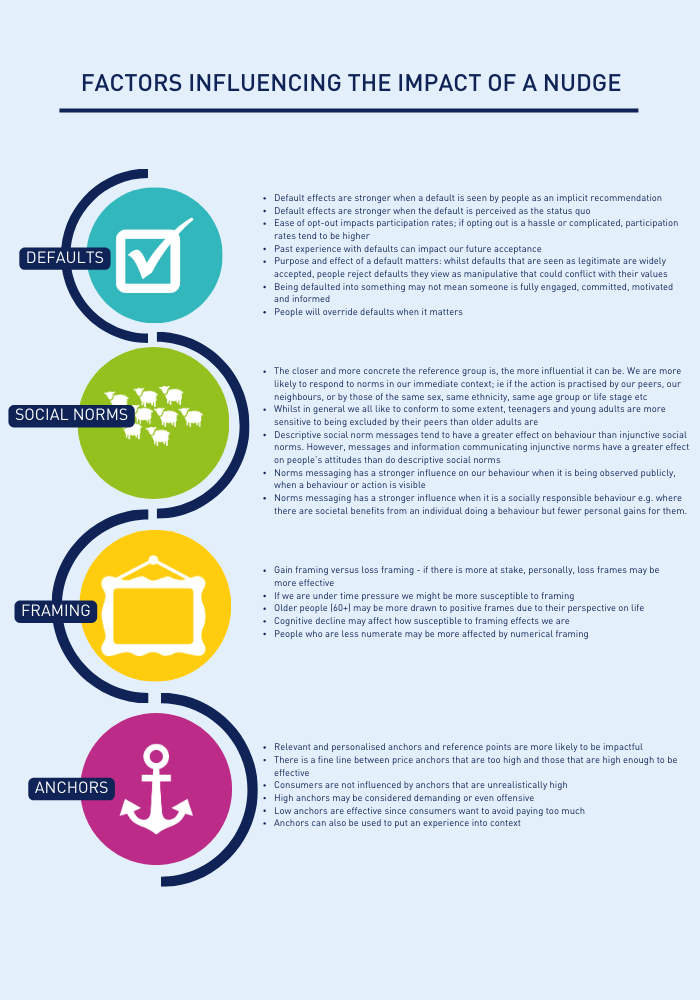In this final part of the series, we begin by explaining how to analyse and approach a behavioural challenge given the context and what is in our control to change. A careful initial analysis of context can help manage expectations.
Once we have established contextual parameters we look at the ‘how’, identifying which behavioural science tools and concepts are best suited to apply in that particular context, by looking at some of the factors which can affect the impact of behavioural science concepts.
Assessing the scope of possibility
Experts say it’s important to manage our expectations by asking the right questions. The most important question to ask is:
‘How much behavioural change is possible, assuming we do everything right?’
For example, could we increase those doing a particular behaviour from the minority to a vast majority? Or is it more likely that we can increase the numbers of people doing something very occasionally to every week or every day? Or are the impacts likely to be more marginal?
We can assess the scope of possibility with two further questions:
1. Within the established context, what variables do you own or have a direct influence upon? Even the most effective nudge may be limited by what can be controlled, or what it is possible to change. For example, companies may be limited by regulation or ethics; or environments not in their control: policymakers may be limited in what they can change by funding, existing legislation and systems and, of course, political will. By asking this question we might find we only have the opportunity, freedom, or control to seek marginal gains – we might have one hand tied behind our backs. For example, are you trying to change a big behaviour like reducing food waste where there are multiple stakeholders? Asking the question around control and influence can help define how much is realistically possible and what you can reasonably expect.
2. What is the minimal impact that would make a meaningful difference? In certain contexts small changes make a big difference
Whilst we’d all love to achieve a 100% uplift, that’s rarely feasible, yet that does not mean smaller uplifts are not worthwhile. However, it is important to find a minimum threshold for a meaningful difference; and to ask what amount of change is realistic and worthwhile. Impact could be an uplift in the number of people participating, people doing a behaviour more frequently, more intensely and/or more correctly. Morningstar, the financial services provider set a “Minimum Meaningful Effect” (MME) for any behavioural intervention. What minimum impact is needed for your organisation?
Different contexts can create different requirements – sometimes we need what we might call a ‘behavioural revolution’, a complete switch in behaviour across the majority of a population. For example, in the Covid-19 vaccine roll-out, countries needed as close to 100% take-up as possible to prevent deaths, hospitalisations and long covid, and they had large budgets and resources to help achieve this. In other contexts, smaller tweaks in behaviour might lead to a one or two percentage point gain in market share or participation, which, while it sounds small, often converts to meaningful impact for customers or revenue and is a worthy return on investment.
We should also ask ‘are people leaning into the change or nudge’? To be honest, many behaviours are simply really hard to shift so even a tiny uplift is a big achievement and worthwhile. This strategic frame can help define what is actually possible in a realistic way. And factoring in the return on investment here is useful. If it costs very little in time and money and there are no company politics (an easy win) even a small change is worth pursuing. Even with a hard challenge, where only small changes are possible, making a series of marginal gains could be productive and cost effective. In its initial two years, the UK’s Behavioural Insights Team achieved more than £300m of gains across its projects by focusing on small, inexpensive changes where the impacts on decision-making and behaviour all added up.
We can now think more strategically about the ‘how’: How can we optimise behavioural science tools and concepts for our context?
Deciding which cognitive biases or behavioural science concepts to leverage in the targeted context is best approached strategically using the framework above. It’s also important to consider the impact of concepts both in isolation and in combination with others.
As some behavioural science concepts have been more widely tested and well-understood than others, there is an ever evolving hierarchy, where concepts including framing, anchoring, social norms, default effects and implementation intentions are some of the more deeply explored concepts (some of which we explored in our New Frontiers article series). At The Behavioural Architects we base our work on a core collection of around 40 concepts and cognitive biases which, over the last decade, we have found to be consistently relevant and applicable to our clients’ behavioural challenges and which also draw on a strong evidence base. Other concepts like hot hand fallacy and pareidolia are a little more niche and are usually less relevant for addressing the challenges and opportunities our clients tackle most often. A few concepts, like dynamic norms, are relatively new and, whilst they show promise, they are, at present, little tested. This means we don’t have a wealth of evidence to draw on across contexts and application would have to be explorative.
Beyond these considerations, it’s important to ask which behavioural science concepts it is feasible to apply in the context in order to change the target behaviour using the strategic framework above. By now, of course, you will have researched the context, and will know what you can or cannot influence and have set expectations with other stakeholders.
As we saw in the second part of this series, nudges can vary hugely in their impact. Often this can be down to subtle nuances in application and the characteristics of the context. Over the last decade behavioural scientists have learnt a lot about these nuances and every day we increase our understanding of which factors can influence outcomes.
Below, we illustrate this learning across four concepts – again looking at the nuances around default settings, social norms, framing and anchoring.
- Defaults: We tend to stick with what has already been selected for us – the ‘default’ – rather than think harder to make our own decision
- Social norms: We like to do what others are doing and look to other people to guide us – valuing their opinions and emulating their behaviours.
- Framing: The way information is presented – ordered or framed – has a significant impact on decision making. For example, it might focus on what people might gain or lose.
- Anchoring: We look for reference points (anchors) that we can rely on and adjust our judgements and decisions from
Taking the time and investment to fully explore and understand the evidence base around these nuances before designing any intervention will increase the likelihood of its effectiveness. Such nuances also mean you may need to segment your target audiences and apply different nudges to different groups, customising and personalising to some degree.

This three part series has offered a strategic framework to set expectations for nudging and behavioural change interventions. It has sought to correct misunderstandings and mis-use and prevent them occurring in the future. Adopting a strategic approach to nudging - a set of pragmatic questions to ask - can help to set clear expectations of the potential impact of any nudge.
Acknowledging the fact that not all nudges are equal, with considerable range in the size of impacts, allows us to set more realistic expectations. By analysing the context where we are seeking change we can better understand the opportunities available to us and manage expectations so stakeholders are happy with the final outcomes. And by asking ourselves about the feasibility of different concepts in the context in which we are working, we can carefully reduce the chances of failure and error and maximise chances of success.
Strategic framework - decision checklist
Analyse the context in which we are seeking behaviour change:
a. Overarching question: How much behavioural change is possible assuming we do everything right?
b. Within the context, what variables do you own or have a direct influence upon? What variables could you obtain control of together with other stakeholders?
c. What is the minimal impact that would make a meaningful difference? This could be uplift in participation, people doing a behaviour more frequently, more intensely and/or more correctly.
d. Which factors in your context could influence the impact of a nudge? How can you optimise a nudge so it works most effectively?
Written by Crawford Hollingworth, Liz Barker and Lucy Pilling - The Behavioural Architects
